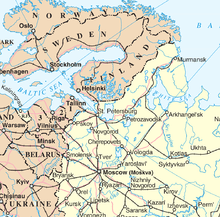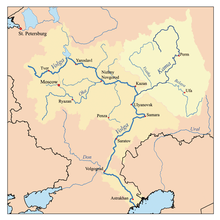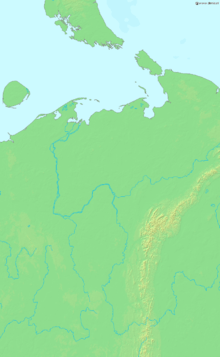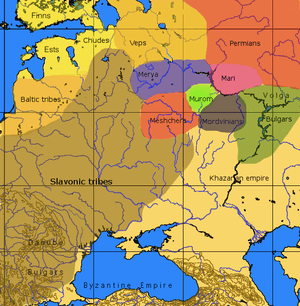Northwest Russia
Northwest Russia or Northern European Russia can be roughly defined as that part of European Russia bounded by Finland, the Arctic Ocean, the Ural Mountains and the east-flowing part of the Volga River. Although it was never a political unit there is some reason for treating it as a distinct region.


The Volga marks the approximate northern limit of moderately dense settlement. The area to the north was valued mainly as a source of fur. The western side was the main source of squirrel, for which there was a large demand during the Middle Ages. Luxury fur, especially sable, came mostly from the northeast.
Last glacial period
The Weichselian glaciation that came to cover much of northwestern originated most likely from small ice fields and ice caps in the Scandinavian Mountains before the ice spread eastward.[1] In northwestern Russia the Fennoscandian Ice Sheet reached its Last Glacial Maximum (LGM) extent 17 ka BP, five thousand years later than in Denmark, Germany and Western Poland. In Russia the LGM ice margin was highly lobate. Lobes originated as result of ice flow following shallow topographic depressions filled with soft sediment substrate. The whole of the basins of the Lake Ladoga, Lake Onega and the White Sea were glaciated at the time of the LGM. These basins possibly canalized the Weschelian ice into streams that feed the lobes found further east and south.[2] Highlands made up of hard bedrock like Valdai and Tihvin had the opposite effect of diverting ice into basins.[3] The three main lobes of the Fennoscandian Ice Sheet in Russia during the LGM followed the basins of Rybisnk and the rivers of Dvina, Vologda.[2] By 13 ka BP the ice margin had receded towards the west and northwestso that all of Lake Ladoga, Lake Onega were free of glacier ice as was almost all of the White Sea and the Kola Peninsula. As the ice margin continued to recede towards the west despite occasional re-advances by 10.6 years BP the Fennoscandian Ice Sheet had left Russia.[2] North of the Kandalaksha Gulf, in Murmansk Oblast, the Fennoscandian Ice Sheet was mostly cold based while south of the gulf it was warm based.[2]
Geography
Before modern times most transport was by river. Therefore, much of its history and geography depends on the river system. From the site of Saint Petersburg one route runs south to the Black Sea and a shorter one goes to the headwaters of the Volga. The east-west routes are the Volga, the Sukhona route across the center, a northerly route parallel to the Arctic coast and the Arctic. The Northern Dvina drains the center and flows northeast into the White Sea. In the east the Pechora River flows northwest-north to the Arctic and the Kama River flows southwest to the Volga bend at Kazan.

Trade route from the Varangians to the Greeks: (this was the main axis of Kievan Rus'). From the site of Saint Petersburg (founded in 1703) east up the Neva River to Lake Ladoga, south up the Volkhov River past Staraya Ladoga to Novgorod (founded 860 or before), south across Lake Ilmen and south up the Lovat River. From the Lovat portage to the headwaters of the Western Dvina, portage to the upper Dnieper River and south to Kiev and the Black Sea. From portages around the Lovat one could go west down the Western Dvina to Riga or east to the upper Volga River.
Volga-Baltic Waterway: Gulf of Finland, Neva River to Lake Ladoga, then northeast up the Svir River to Lake Onega, southeast up the Vytegra River, portage, down the Kovzha River to Lake Beloye and southeast down the Sheksna River to Rybinsk at the northernmost point of the Volga River. Today the entire route is canalized and the lower Sheksna is part of the Rybinsk Reservoir. The Northern Dvina Canal branches northeast to the Sukhona River (next section).
The Sukhona Route and Veliky Ustyug: This route crosses the center along the Sukhona and Vychegda Rivers which join near Veliky Ustyug and links Novgorod to the Kama River and Kazan. From Veliky Ustyug one can go west up the Sukhona, east up the Vychegda, northwest down the Northern Dvina to the White Sea, or south up the Yug River and down the Unzha River to the Volga and Kazan. From the upper Sheksna south of Lake Beloye, portage to the ? river and downstream to Lake Kubenskoye. (This is now the Northern Dvina Canal. Vologda is just south of lake Kubenskoye.) From Lake Kubenskoye east northeast down the Sukhona River about 400 km to Veliky Ustyug where the Yug River comes in from the south. The river now gains the name of Northern Dvina and flows about 60 km northeast to the modern town of Kotlas where the Vychegda River comes in from the east. From Kotlas east at least 400 km up the Vychegda to its headwaters west of the Urals. From here portage north to the Pechora or south to the Kama, both of which lead to passes over the Urals.
Northern East-West Route: This was the main axis of Novgorod's expansion. It skirts the southeast side of the White Sea and then crosses to the Pechora. Lake Onega, east up the Vodla River, portage to the Onega River basin, east across this, portage, down the Northern Dvina to Kholmogory near the White Sea, east up the Pinega River, portage to the Kuloy and north to the Mezen Bay of the White Sea. East up the Pyoza River, portage, down the Tsilma River to the west-flowing part of the Pechora.
Pechora River and Ural Passes: 1. From the northern east-west route up the west-flowing part of the Pechora River, up the Usa River, over the easy Kamen portage of the Urals and down the short Sob River to the lower Ob River. 2. From the middle Pechora, up the Shchugor River, over either of two Ural passes and down the Northern Sosva to the Ob. 3. From the upper Pechora, over the Urals and down the Pelym River. 4. From the headwaters of the Vychegda to branches of the upper Kama River, across the middle Urals and down branches of the Tavda River to Tobolsk on the Ob.
North-South Routes: 1. From Kazan northeast up the Kama River, portage to the Pechora or Vyshegda. 2. From Kazan up the Volga past Nizhny Novgorod to the point where the river turns from east to south, north up the Unzha River, portage, down the Yug River to Veliky Ustyug. 3. From the middle Vychegda, north up the Vym River, portage, east down the Ukhta River, north up the Izhma River to the Pechora. 4. From Moscow one route was northwest up the Moskva River to Volokolamsk and down the Lama River and Shosha River to the Volga. This was replaced by the current Moscow Canal further east.
Peoples

Russians expanded slowly from the south. Those along the White Sea came to be called Pomors. The original population spoke Uralic languages. The Chuds were proto-Estonians. The Ves' lived east Lake Ladoga and were pushed toward the Dvina by the expansion of Novgorod after 1100. The Vychegda Permians lived on the Vychegda while the state of Great Perm was on the upper Kama. The Permians were later called Zyryans and later Komi. The Arabic term Wisu probably meant Great Perm, but it might have referred to the Ves'. The Voguls lived on the upper Kama and Pechora and the Ostyaks or Yugra on the lower Pechora. The Samoyeds lived in the far northeast. The Burtas were ancestors of the Mordvins.
Zavolochye (meaning "beyond the portage") is a geographic term referring to some of the area between Lake Onega and the lower Dvina.
History
Since this thinly-peopled area developed no significant states, its history is mostly about states south of the Volga and their attempts to control the northern fur trade.
By Date: circa 800: Volga Bulgaria. c 860: Kievan Rus'. by 1096: whole area under Russian tribute except Bulgars. 1212: Veliky Ustyug founded. 1221: Russia takes Nizhny Novgorod from Bulgars. 1240: Mongols conquer Russia. 1445: Kazan independent. 1460: Moscow controls the northeast. 1478: Moscow takes Novgorod. 1480: Moscow independent from the Golden Horde. 1552: Moscow takes Kazan. 1582: Conquest of Siberia begins.
The Volga Bulgars and Kazan: Persian coins found in the Kama region dating from the fifth to the seventh century imply that something was being exported down the Volga at that time. Volga Bulgaria was established on the Volga bend near Kazan about 800. They collected tribute from the neighboring tribes and in turn paid tribute to the Khazars on the lower Volga. About 922 they adopted Islam (about 66 years before the Rus' became Christian). They blocked the Rus' from sailing down the Volga but bought Rus' furs and resold them to merchants coming upriver from Khazaria and central Asia. In 965 the Rus' destroyed the Khazar empire. There were numerous Rus'-Bulgar wars, with the border being roughly from Rostov southeast to Murom. About 1150 the rising power of Rostov reduced Bulgar fur supplies and forced its trade north to what later became Veliky Ustyug. In 1236 the Volga Bulgaria was conquered and devastated by the Mongols, but later Mongol demand for tribute increased its fur trade as did the destruction of the Kiev trade. By 1300-1350 it had an active trade extending up the Kama to Great Perm and Yugra. After 1350 the breakdown of the Golden Horde made the Volga route difficult, Muscovite expansion to the Vyshegda reduced fur supplies and Novgorodian pirates called "ushkuiniks" raided the northern rivers. In 1445 the area became independent as the Khanate of Kazan and developed a trade in luxury fur from the northeast and Siberia down the Volga, but Moscow controlled the lands further north. There were many Russo-Kazan Wars, but Kazan also sold fur to Moscow. Moscow conquered Kazan in 1552.

The Rus': Around 862 Scandinavians arrived in Russia via the Gulf of Finland and the Western Dvina. They quickly adopted the local Slavic languages and became known as Rus'. They built a system of principalities from the Volga south to the steppe and traded south to Byzantium and eastward to the Bulgars.
Novgorod: In 1096 Novgorod was collecting tribute as far northeast as the Pechora. By 1350 its claim to rule the Yugra and Perm areas was recognized by the other Russian states. It built a series of "Pogosts" or forts along the "northern east-west route", reaching the Pinega by 1137, and used them to collect tribute from the local population. From around 1150 it pushed south to the upper Sukhona and used this route to trade with the Bulgars and also for some raiding. About 1200 Veliky Ustyug was founded by the ruler of Rostov, partially blocking this route.
From about 1200 Germans colonized the Baltic coast from Estonia to East Prussia. Byzantium declined after 1204 and the Mongols destroyed Kiev in 1240. The effect was to reorient Novgorod's trade westward and partly separate it from the rest of Rus'. Novgorod became the eastern anchor of the Hanseatic League and its government became dominated by its merchants. Instead of exporting Byzantine and Arab luxury goods to Scandinavia, it exported fur via Hanseatic merchants to western Europe. The main export was grey squirrel for which there was a large demand during the Middle Ages. This reliance on squirrel partly explains why Novgorod relinquished the northeastern sources of luxury fur to Moscow. From about 1320 we began to hear of landed estates and peasant communities in an area that almost reached the Dvina, a system that was well-developed by 1450. Boyars received about half their rent in fur. From about 1440 the Novgorod fur trade broke up. Western demand for squirrel declined and Moscow controlled the sources of luxury fur east of the White Sea. Moscow annexed Novgorod in 1478 and systematically broke up her commercial institutions.
Rostov-Suzdal: By about 1150 Rostov had enough control of the upper Volga to block direct trade between the Bulgars and Novgorod. From 1164 to 1221 Suzdalia pushed east to the mouth of the Oka River. This gave them control of the Volga from Yaroslavl north of Rostov to the mouth of the Oka at Nizhny Novgorod (founded in 1221) and the Unzha-Yug route from the Volga to Ustyug (founded about 1212) which the Bulgars had previously controlled and gave them some control over Novgorod's Sukhona route. From around 1400 we hear of Rostov granting estates west of the lower Dvina in what was Novgorod territory.
Muscovy: About 1328 Ivan Kalita of Moscow gained control of Ustyug and Belozersk and used it to tax Novgorod's fur trade in order to collect wealth which he sent in tribute to the Golden Horde. From about 1350 Moscow developed its own fur trade and gained increasing control over the Perm-Pechora region. About 1363 it gained some control over Rostov and from 1367 some control over Perm. About 1376-86 Saint Stephan of Perm converted the Vyshegda Permyaks to Christianity which had the indirect effect of bringing the region under the control of Moscow. In 1397-1425 Moscow tried to reach the lower Dvina but was pushed back by Novgorod. Around 1400 the weakening of the Golden Horde shifted the fur trade from tribute down to Volga to commercial exchange through Crimea. By 1462 Moscow controlled Vologda, the eastern side of the White Sea and the lower Dvina. About 1458 Moscow gained control over the Vyatka River branch of the Kama, thereby reducing Kazan's control of the north. After 1472 tribute from Great Perm was increased. In 1465 Moscow imposed tribute on Yugra. In 1483 Muscovites under Fyodor Kurbsky raided across the Urals down the Pelym River into the lands of the Khanate of Sibir. In 1499 Muscovites use the 'northern east-west route' to attack the Samoyeds and sent parties across the Urals to Pelym. From around 1500 there were increasing overland exports of luxury fur to Western Europe. In 1566 the Stroganovs were granted extensive lands around Perm. In 1582 Yermak began the Russian conquest of Siberia. Many, perhaps most, of the explorers of Siberia came from northwest Russia.
Notes and references
| Wikivoyage has a travel guide for Northwestern Russia. |
- Fredin, Ola (2002). "Glacial inception and Quaternary mountain glaciations in Fennoscandia". Quaternary International. 95–96: 99–112. doi:10.1016/s1040-6182(02)00031-9.
- Stroeven, Arjen P.; Hättestrand, Clas; Kleman, Johan; Heyman, Jakob; Fabel, Derek; Fredin, Ola; Goodfellow, Bradley W.; Harbor, Jonathan M.; Jansen, John D.; Olsen, Lars; Caffee, Marc W.; Fink, David; Lundqvist, Jan; Rosqvist, Gunhild C.; Strömberg, Bo; Jansson, Krister N. (2016). "Deglaciation of Fennoscandia". Quaternary Science Reviews. 147: 91–121. doi:10.1016/j.quascirev.2015.09.016.
- Kalm, Volli; Gorlach, Aleksandr (2014). "Impact of bedrock surface topography on spatial distribution of Quaternary sediments and on the flow pattern of late Weichselian glaciers on the East European Craton (Russian Plain)". Geomorphology. 209: 1–9.
Janet Martin, Treasure from the Land of Darkness: The Fur Trade and its Significance for Medieval Russia, 1986, which this article partly summarizes.